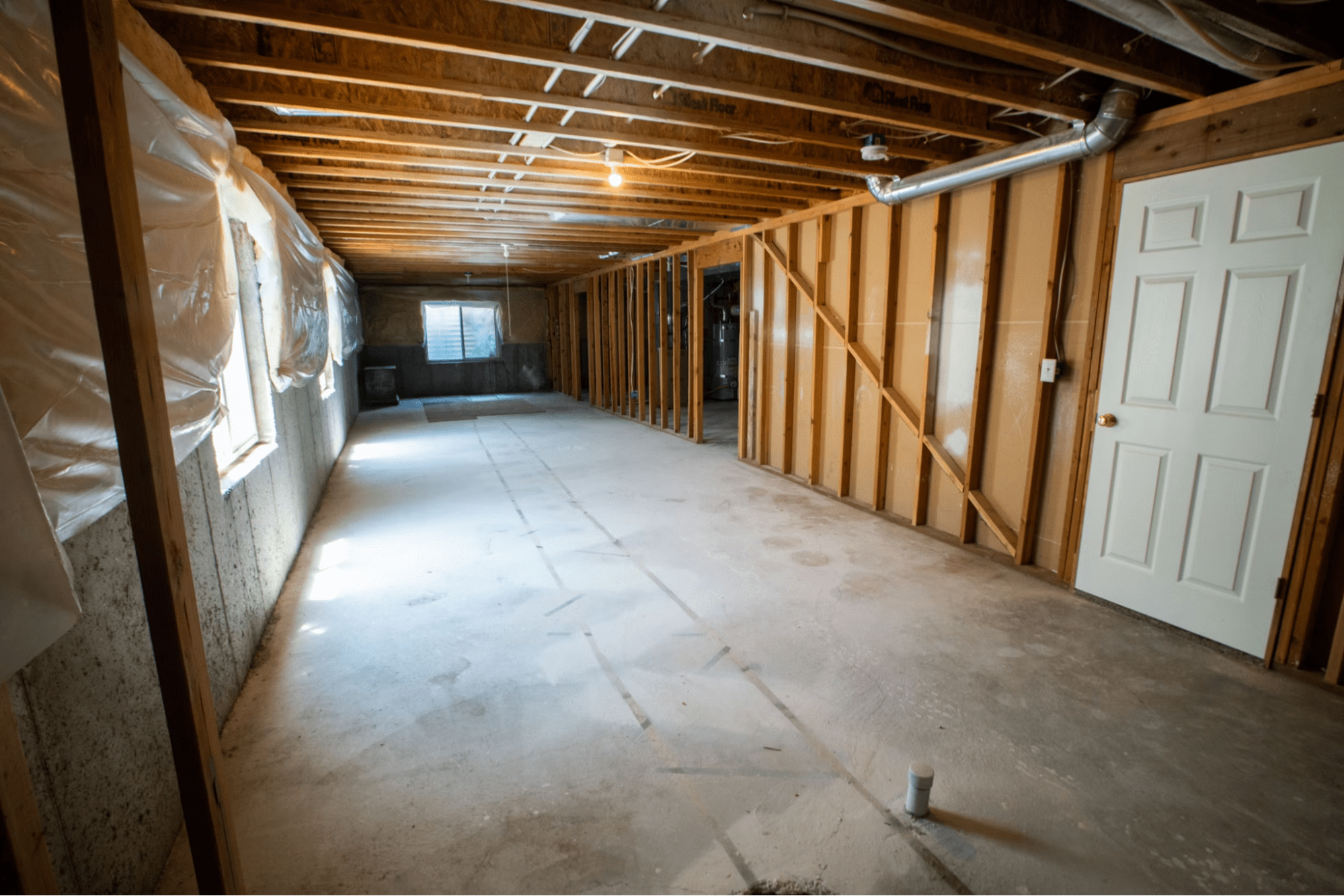Basements are particularly vulnerable to water seepage and flooding as they're located below ground level, directly exposed to soil moisture and pressure from groundwater. And, without proper waterproofing measures, even the most meticulously executed remodeling projects can be compromised. As a contractor or construction professional, it is essential to have a solid understanding of the best basement waterproofing strategies to excel in this type of project.
This blog will explore the ten best basement waterproofing strategies, key considerations before waterproofing, some common mistakes to avoid, and more that will help you build a strong foundation and safeguard your projects against water-related issues.
Knowing the Best Way to Waterproof a Basement
Basement waterproofing is crucial in protecting against water infiltration, which can cause structural damage, mold growth, and poor indoor air quality. By preventing moisture from seeping into foundations, walls, and floors, effective waterproofing ensures the longevity and durability of your construction projects. Prioritizing these techniques not only sets your services apart in a competitive market but also supports sustainable construction practices and enhances overall customer satisfaction.
Best Basement Waterproofing: Identifying Potential Reasons for a Wet Basement
Addressing basement waterproofing issues requires a comprehensive approach that goes beyond surface solutions. You can implement effective strategies and provide expert solutions to your clients by knowing and pinpointing the underlying reasons for water infiltration. Let’s take a look at some of them below:
- Hydrostatic Pressure: When groundwater accumulates around the foundation, it exerts pressure on basement walls and floors, leading to cracks and water seepage.
- Poor Drainage Systems: Inadequate drainage systems fail to divert water away from the foundation, resulting in water accumulation that can compromise structural integrity.
- Foundation Cracks: Natural settling or poor construction practices can cause foundation cracks, allowing water penetration. Cracks wider than one-eighth of an inch, especially with visible moisture after rainfall, require targeted sealing solutions.
- Ineffective Sump Pumps: Malfunctioning or improperly installed sump pumps cannot efficiently manage excess water, leading to potential basement flooding.
- Gutter and Downspout Issues: Improper installation or clogging of gutters and downspouts directs water toward the foundation, exacerbating water infiltration problems.
- Faulty Basement Waterproofing: Improper application or deterioration of sealants, membranes, or coatings can compromise the basement waterproofing system, allowing water penetration.
- High Water Table: During heavy rainfall or snowmelt, a high water table exerts pressure against basement walls, causing water to seep through cracks or joints.
- Condensation: Elevated humidity levels in the basement can lead to condensation on walls and floors, contributing to moisture-related issues and potential mold growth.
- Plumbing Leaks: Leaking pipes or fixtures within or near the basement introduce water into the space, necessitating prompt detection and repair to prevent water damage.
- Efflorescence: The presence of a powdery residue on walls indicates moisture penetration.
10 Best Basement Waterproofing Strategies
Effective waterproofing strategies are crucial for maintaining a dry and structurally sound basement. Here are ten best ways to waterproof a basement:
1. Exterior Waterproofing
Exterior waterproofing involves creating a physical barrier between the foundation walls and surrounding soil to prevent water penetration. This method typically involves excavating around the foundation to expose the walls, applying a waterproof membrane (such as bituminous or elastomeric membranes) to the exterior surface, installing drainage boards to facilitate water drainage, and using proper backfill materials that promote proper drainage away from the foundation.
Additionally, exterior waterproofing offers comprehensive protection and preserves interior finishes for finished basements or homes where water flows toward the foundation.
2. Interior Waterproofing
Interior waterproofing focuses on managing water that has already penetrated basement walls or floors. This type of waterproofing is effective when dealing with rising groundwater or when exterior excavation space is limited, such as in townhomes or small lots.
It involves applying waterproof sealants or coatings to create a moisture-resistant barrier. Vapor barriers may also be installed to prevent moisture from migrating through the walls. Vapor barriers are particularly effective in areas with high humidity levels, preventing moisture-related issues. Additionally, installing a sump pump system with a battery backup ensures effective water removal during heavy rainfall or sump pump failure.
3. Sealants and Epoxy Injections
Sealants and epoxy injections are used to repair and seal cracks, voids, and gaps in basement walls and floors that can serve as entry points for water. High-quality sealants, such as polyurethane sealants or epoxy injections, are injected into cracks under pressure to ensure a complete seal.
4. Comprehensive Drainage Solutions
Comprehensive drainage solutions are essential for managing groundwater and surface water around the foundation. Installing French or perimeter drains around the foundation helps collect and redirect water away from the building or structure.
Additionally, check if the gutters and downspouts are clean and properly functioning. This is to ensure that rainwater is effectively diverted away from the foundation, minimizing the risk of water infiltration.
5. Moisture Control
Controlling indoor humidity levels is essential for preventing mold growth and maintaining a dry basement environment. Implement dehumidifiers and ventilation systems to maintain optimal indoor humidity levels and prevent moisture buildup in the basement.
Dehumidifiers remove excess moisture from the air, while proper ventilation systems ensure adequate airflow to prevent condensation and moisture buildup on basement walls and floors.
6. Advanced Coatings and Technologies
You might also want to consider using advanced waterproofing technologies such as elastomeric coatings that expand and contract with building movement or crystalline waterproofing agents that penetrate concrete and form crystals to block water pathways, offer enhanced protection against water infiltration. These technologies are particularly beneficial for challenging waterproofing scenarios or unique project requirements.
7. Waterproofing Paints and Coatings
You can opt to apply specialized paints and coatings designed for basement environments. These products create a durable moisture barrier on basement walls and floors, adding an extra layer of protection against water penetration.
8. Window Well Covers
If your client wants added protection, consider installing window well covers to prevent water from accumulating around basement windows. Window well covers protect basement windows from water infiltration and potential damage.
9. Sub-Slab Drainage System
For areas with high water tables, consider installing a sub-slab drainage system beneath the basement floor. This system collects and redirects water away from the foundation before it can cause damage.
10. Regular Maintenance
Regular maintenance is crucial for prolonging the lifespan and effectiveness of waterproofing systems. To ensure their continued effectiveness, schedule routine inspections and maintenance of all waterproofing systems, including sump pumps, drainage systems, and exterior membranes. This helps identify and address potential issues before they escalate into costly repairs or water damage.
Best Basement Waterproofing: 5 Common Mistakes to Avoid
Even professionals often make common mistakes when it comes to basement waterproofing. With the right knowledge and expertise, you can achieve the best way to waterproof a basement. Below are some common mistakes to avoid:
- Neglecting Proper Drainage Systems: Failing to install or maintain an adequate drainage system is a common oversight. Ensure you have a comprehensive system that includes exterior and interior drainage to prevent water from accumulating around the foundation.
- Insufficient Surface Preparation: Failing to adequately clean and prepare basement walls and floors before applying waterproofing materials can compromise adhesion and effectiveness. Ensure that the surface is clean, dry, and smooth. Remove any efflorescence, mold, or previous coatings that could hinder adhesion.
- Ventilation Oversight: Inadequate basement ventilation can lead to moisture buildup, contributing to mold growth and undermining waterproofing efforts. Ensure there is adequate airflow to prevent moisture accumulation.
- Improper Sump Pump Installation: Incorrect installation, sizing, or maintenance of sump pump systems can result in inadequate water removal during critical periods, leading to basement flooding. Ensure the sump pump is correctly installed and appropriately sized for the basement.
- Choosing the Wrong Waterproofing Products: Choosing the wrong materials for the job can compromise the effectiveness of your waterproofing efforts. Select the appropriate product based on the basement's conditions, such as hydrostatic pressure, soil type, and climate.
7 Tips for the Best Basement Waterproofing
Aside from the ten best basement waterproofing strategies, you can also enhance your waterproofing efforts with these seven tips for the best way to waterproof a basement:
- Site Evaluation: Conduct a thorough assessment of the surrounding landscape, soil conditions, and water table levels to determine the extent of potential water infiltration risks.
- Compliance with Regulations: Familiarize yourself with local building codes and regulations governing basement waterproofing to ensure compliance and safety.
- Custom Solutions: Tailor waterproofing strategies to each project's specific conditions. Consider factors such as local climate, soil composition, and the building’s age and construction type.
- Climate Considerations: When designing waterproofing solutions, consider the local climate and weather patterns. Areas with heavy rainfall or high water tables may require more robust systems.
- Education and Training: Continued education and training will keep you up to date with the latest waterproofing technologies and methods. This will ensure that you are equipped with the knowledge to implement the most effective solutions.
- Proper Landscaping: Ensure that the landscaping around the building slopes away from the foundation. This prevents water from pooling near the foundation and seeping into the basement.
- Interior vs. Exterior Approaches: Evaluate the benefits and limitations of interior versus exterior waterproofing methods based on the severity of water infiltration issues, cost considerations, and project goals. While exterior waterproofing is more comprehensive, it is also more invasive and costly. Interior solutions, although easier to implement, may not address the root cause of water infiltration.
FAQs About the Best Basement Waterproofing
To guide you more thoroughly in conducting the best way to waterproof a basement, here are some frequently asked questions that professionals in the construction and remodeling industry should know:
1. What is the Best Material for Waterproofing Basement Walls?
There is no definitive best material for waterproofing basement walls. Epoxy, polyurethane, and cementitious materials are commonly used and effective for this purpose. In severe cases, epoxy and polyurethane typically provide the best results, while cementitious materials offer cost savings.
2. How Do You Determine the Best Waterproofing Solution for a Specific Basement?
To determine the best basement waterproofing solution for a specific basement, assess the following factors: the basement's location, soil conditions, foundation type, existing water issues, and your client's budget considerations.
3. What is the Best Moisture Barrier for a Basement?
Contractors often use polyurethane sheeting as a vapor barrier to stop moisture from entering basement walls. This material is stapled to the basement wall frame before finishing it with plaster or drywall.



